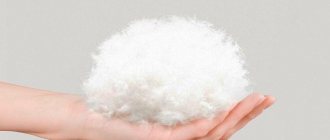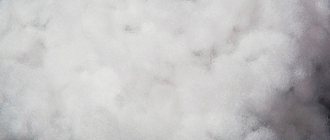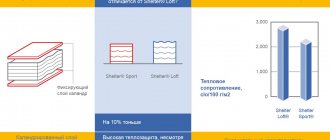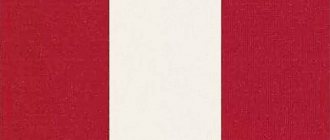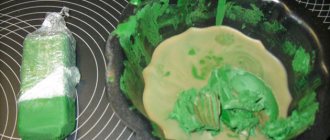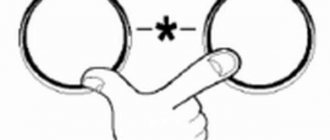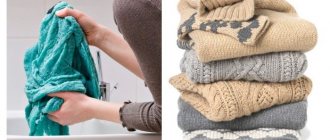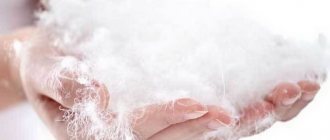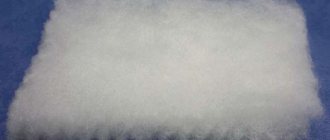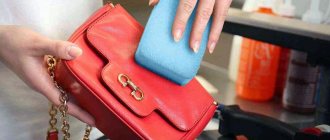Despite the growing popularity of natural materials, synthetic insulation is still in demand. Along with holofiber and thinsulate, bio-down is used when sewing outerwear. Not every buyer knows what kind of material this is. Although this type of insulation is well known among manufacturers for its high performance characteristics and affordable price.
What is biofluff
Bio-down (eco-down) is a unique material. It combines the characteristics of natural filler - swan and duck down and modern synthetic analogues. On the one hand, bio-down is distinguished by its low weight and heat capacity, on the other hand, it is hypoallergenic and relatively easy to care for. Thanks to this, things with bio-down can be machine washed and even after that the filler does not lose its unique properties.
Bio-fluff is often confused with synthetic fluff. Both materials have similar characteristics. They recover from deformation, are waterproof, durable and wear-resistant. Both fillers are hypoallergenic, environmentally friendly and breathable.
However, there are still differences. Synthetic fluff is cheaper and has better water-repellent characteristics. Bio-down retains heat better and does not lose this property even after numerous washes. So, despite the similarity, these are two different types of insulation. Which is better: bio-down or synthetic-down depends on the operating conditions.
Origin story
Biofluff was invented by accident. In the early 1970s, at the 3M chemical factory, which specialized in the production of adhesive tape, a technical error occurred during the mixing process. As a result, instead of raw materials for making adhesive tape, we got an unusual porous biopolymer with unique properties.
The discoverer did not need bio-down, but the DuPont concern became interested in the unusual polymer. Having purchased the substance from 3M, it was patented under the name “Sorona”. This became the future basis of bio-fluff, which was created from renewable biological components processed using special technology. The resulting material was called biofluff.
Success came very quickly. Already in 1973, NASA used bio-down as insulation for spacesuits. Products with bio-down arrived on store shelves after 6 years. These were mainly sports and casual winter clothing, which very quickly gained popularity among customers.
Today, among synthetic fillers, bio-down takes first place in terms of thermal insulation characteristics. In terms of its performance, it is closest to natural bird down and is an order of magnitude superior to other synthetic fillers.
Bio-down – harmless synthetics
Bio-down is a synthetic material used to insulate various products. It was developed by ZM Thinsulate and DuPont in the early 70s. The basis of the filler is a special biopolymer in which the constituent components are constantly renewed.
This is what eco fluff looks like in the photo; it’s practically indistinguishable from natural fluff.
Bio-down is an environmentally friendly material. Its production requires minimal energy consumption and produces much less harmful emissions generated during the production of synthetic materials.
Bio-fluff production
The starting material for the filler is Sorona plant hollow fiber. It is 60 times thinner than a human hair. The fibers are joined together and twisted into a spiral, giving them a 3-dimensional structure. Thanks to this, the “compacted” threads become stronger and more elastic. But most importantly, the resulting material quickly recovers after deformation. It is from “Sorona” that the famous organic down “Sustans” is produced.
The second stage is the application of a thin layer of silicone to the twisted fibers. This substance not only retains air bubbles, providing heat-saving characteristics, but also gives the material water-resistant properties.
The final stage is “beating” the threads, resulting in a fluffy, light white mass. During the production process, various additives (polyethylene styrene, polyolefin) can be added to the fiber composition. They can give the insulation additional properties.
What does this insulation look like?
It is not difficult to understand what bio-fluff is. It resembles ordinary cotton wool, it is silky, resilient and elastic. Its fibers form small balls, making the material heat-intensive.
If an unnatural filler is used in production, this does not mean that the product will be of poor quality. Modern production has achieved good results, and artificial raw materials are many times superior to natural ones. Eco-insulation is made from plant materials, which are then chemically treated.
Through fermentation, polymer threads are created, which take on a spiral shape and are coated with silicone. Thanks to this, any deformation of the material is not dangerous; it instantly returns to its previous state.
To prevent synthetic bio-down from being spoiled by moisture and mechanical stress, polyester and polyethylene styrene components are added to its composition. Externally, the material resembles natural wool, because... both insulation materials have a spiral shape.
Types of bio-fluff
Modern production of bio-down involves the production of several modifications. They are marked as follows:
- "WITH". Standard version with subtypes “CS” and “CDS”. The filler is fixed to the material using glue. Can be used either separately or in combination with other insulation materials.
- "CS". Consists of several layers: synthetic fluff on a non-woven basis and bio-down. Together, both fillers are combined using ultrasound. As additional fixation, stitching is used at intervals of 25 cm.
- "CDS". Improved version of "CS". It is fixed in the seams and does not require additional stitching.
- "TIB". The most voluminous filler with a high content of polyester fibers.
- "P". The fluff of this category does not wrinkle or fall off due to the special surface.
- "B". Category of moisture-resistant bio-down that can withstand many deformations.
- "FR". A type of fire-resistant bio-down that is made by adding polyethylene styrene and meta-aramid fibers.
Each type of bio-down is used for sewing a certain category of clothing in specific climatic conditions.
Temperature
It is believed that bio fluff is a material that can withstand up to -40 degrees. However, when determining the optimal temperature for wearing clothes, it is necessary to take into account several factors: the body’s ability to resist cold, the type of outer material, and the thickness of the insulation.
When choosing clothes, you need to focus on the density of bio-down filling:
- 100 gsm m: the products warm well at temperatures from -5 to -10 °C. This layer of bio-down is used to insulate demi-season clothing;
- 150 gsm m: thickness is designed for cold temperatures from -15 to -20 °C. The padding is recommended for everyday winter items;
- 200 gsm m: for frosts -20-25 °C;
- 400 gsm m: withstands up to -35 °C. Used for sewing workwear and uniforms.
Important! Manufacturers do not recommend padding thicker than 200 g/m2 for everyday items, as it will be uncomfortable to move in the clothes. To increase the heat-saving properties of the product, you need to use a denser material for the top layer.
Fabric composition and properties
Externally, biofluff resembles wool. Its fibers have the same spiral structure. Moreover, in some cases its properties are superior to natural fillers.
So bio-fluff has the following characteristics:
- thermal insulation (1.5 times better than natural bird down);
- light weight;
- practicality;
- rapid recovery after deformation (due to spiral fibers);
- immunity to pathogenic flora (fungus and mold);
- no chemical odors;
- hypoallergenic;
- water resistance and low hygroscopicity.
Eco-down does not absorb foreign odors, does not pass through the material, and does not get knocked out at seams and stitching. It corresponds to environmental trends, because not a single animal is harmed in the process of its production.
However, it would be wrong not to mention the shortcomings of the filler. When exposed to too high temperatures, for example during automatic drying, the fibers of the material may change their structure. Accordingly, some of the properties of eco-down also change.
Due to the large volume of filler, items with bio-down can add 1-2 sizes to their owner. The material is an order of magnitude more expensive than most synthetic analogues. However, given its long service life, buying things with this insulation is beneficial. Another disadvantage of bio-fluff is that it can accumulate static electricity.
| What is another name for the fabric? | Ecopooh |
| Natural or synthetic? | Bio-based synthetics |
| How does it feel? | Pleasant, soft, airy, light |
| Application | Winter clothing and equipment |
| Fabric structure | Spiral fibers |
| Does it stretch or not? | No |
| Recommended washing temperature: | 40°C |
| Washing mode | Handmade, delicate |
| Squeeze | No |
| Kinds | CS, CDS, C, TIB, B, FR, P |
Useful tips
Clothing manufacturers offer a huge range of stylish and fashionable items insulated with bio-down. The main thing is to choose the most comfortable and pleasant-looking clothes. It is important to pay attention to the quality of workmanship. If the item itself is produced poorly, the effectiveness of the insulation can be significantly reduced.
When choosing winter clothing, you should take into account the thickness of the insulation . It has very high thermal insulation properties, so it is not always advisable to buy models with an excessively thick layer of filler. This is fraught with the formation of a greenhouse effect and discomfort when worn. It is better to dry clothes with bio-down naturally, or in special drying machines at low temperatures.
Application
Eco-down is most often used when sewing winter workwear for fishermen and hunters, tourist bags and equipment, suits and overalls for winter sports (skis, snowboarding).
However, this type of insulation is also used for sewing everyday outerwear: down jackets, jackets, pants. The low weight and plasticity of the filler make clothing made from bio-down light, comfortable and at the same time very warm.
Items with this eco-friendly insulation do not become thinner or deformed after washing, so they last for more than one season.
The use of the material is designed for both moderate and extremely low temperatures. It all depends on the filling density.
Product reviews
I bought a jacket in late fall and couldn’t be happier. Lightweight, comfortable, warms well even at -15 below zero. Before that, I had natural down jackets, and I suffered so much: the pile constantly came out of the seams. And there are no problems with bio-fluff. Olga M., 32 years old, Moscow
I heard a lot about the benefits of bio-down in outerwear, was flattered by the good reviews, so I decided to take a chance with the purchase. I wore the jacket for a couple of months and realized that the clothes didn’t suit me. I'm used to natural fluff, but I didn't like this one. The heat is worse, and when you enter the store from the street, it becomes too hot. The only plus is that it is very easy to wash: I turned on the delicate mode, and after 40 minutes I took out almost dry clothes. Svetlana V., Perm
What I like about bio-down is how easy it is to clean. It washes well, dries quickly, does not wrinkle - in short, the most practical option. I wear it down to -10 degrees. In stronger frosts it’s already cold, so I switch to a fur coat. Alexandra T., St. Petersburg
Advantages and disadvantages
Eco-down is considered one of the first bio-based insulation materials. It quickly gained popularity among manufacturers and buyers due to its many advantages:
- Effective heat saving. The filler works at temperatures down to -40°C.
- Preservation of shape. Due to the spiral structure, the fibers have a reserve of elasticity and do not deform after mechanical stress.
- Easy to care for. Bio-down can be washed both by hand and in a machine. The only thing is that for washing it is better to use not traditional powders, but special shampoos, which are much better washed out of the fibers.
- Light weight. Thanks to the lightness and plasticity of the material, clothing with eco-down does not hinder movement and weighs little. This is important for athletes involved in extreme and other sports.
- Hypoallergenic. The material does not cause negative allergic reactions and can be used, including by children and people with sensitive skin.
- Moisture resistance and bactericidal properties. Eco-down, unlike wool, cannot harbor insects, fungus or mold. The insulation is waterproof and has low hygroscopicity.
It is also worth noting the long service life of the material.
What are they and how do they differ from previous analogues and natural fluff?
Time flows relentlessly and inexorably, days, weeks, months, seasons change. A beautiful winter is creeping up. Living in such harsh weather conditions as in Siberia obliges us to have certain skills in choosing ways to protect ourselves from the cold.
One of the most popular types of outerwear, combining such important qualities as: practicality, comfort, warmth, lightness and affordable price, are down jackets. The name, in this case, speaks for itself. To protect the body from exposure to low temperatures, previously only natural down was used as a heat-insulating filler. But in the modern world there are also many other materials that are created using innovative, progressive technologies.
So let's look at what types of fillings for down jackets exist now and compare the characteristics so that you can be prepared when choosing such an important wardrobe item.
Care: basic rules
Before choosing a down jacket, it is not enough to find out from biodown what temperature it is designed for. It’s a good idea to familiarize yourself with all the nuances of caring for your outerwear in advance. If done accurately, they can significantly increase the service life of clothing.
Here are the main ones:
- The washing temperature should not exceed 40°C.
- When rinsing, use conditioner.
- The highest spin mode is 600 rpm.
- Washed clothes are dried naturally, carefully hung away from heating appliances.
- It is not recommended to dry products in the sun or in direct sunlight.
Compliance with the care conditions will not only have a positive effect on wear resistance, but will also provide the owner of a down jacket or ski suit with comfort in the most inclement weather.

